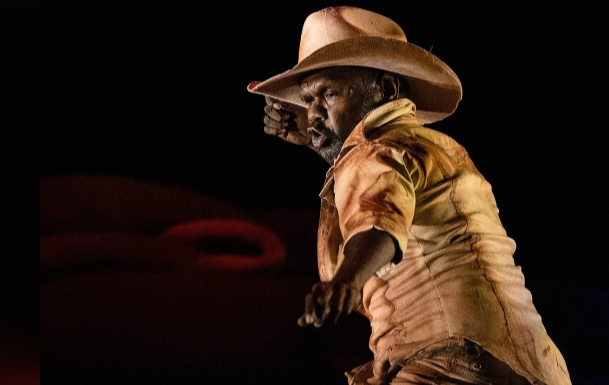Nyuju performed in Coonabarabran for National Sorry Day
Lily Plass
03 June 2024, 7:40 AM
 Aunty Maureen Sulter, Gamilaraay Elder, Coonabarabran giving the Welcome to Country before the performance. Credit: Orana Arts
Aunty Maureen Sulter, Gamilaraay Elder, Coonabarabran giving the Welcome to Country before the performance. Credit: Orana ArtsIndigenous and intercultural dance theatre Marrugeku performed 'Nyuju' at Coonabarabran High School for National Sorry Day on 26 May.
Nyuju Stumpy Brown was a Wangkatjungka painter and law-woman in Western Australia.
As an artist, Ms Brown recreated the desert sites from her childhood. Her parents died when she was young.
Afterwards, Ms Brown was raised by her uncle who was a drover.
In a 2002 ABC radio interview, Ms Brown said she never saw a white person until she was 15.
Her family stories are told through dance, video, and sound by her great-grandson Emmanuel James Brown.
"We were transfixed as he shared parts of his ancestors' storylines," Executive Director of Orana Arts Alicia Leggett said.
Ms Leggett said "the journey through movement and projections" inspired her the most.
“We were so incredibly lucky to have Marrugeku in Coonabarabran and we hope to bring more works of this nature to the region."
If one is open to new ways of experiencing these stories we bring ourselves closer to understanding our First Nations history.

For the past ten years, there has been a National Sorry Day March across the Mary Jane Cain Bridge.
Mary Jane Cain, affectionately known as ‘Queenie Cain’ was a Gomeroi who secured a parcel of land for her family at Forky Mountain in the late 19th century.
She traveled to Sydney in 1885 to secure 400 acres of land as an Aboriginal Reserve.
Her request was granted in 1892. Mary Jane Cain recovered an additional 600 acres between 1902 and 1911.
On this land, Aboriginal families who had been displaced were able to build a home and find a community even decades after Mary Jane Cain died in 1929.
Mary Jane Cain penned out a 23-page manuscript in 1920 including her life story, observations of landowners and workers, and a collection of Gomeroi words.
Marrugeku also worked with students from Wellington High School on 19 May and taught them about intercultural storytelling methodologies and telling stories through movement.



